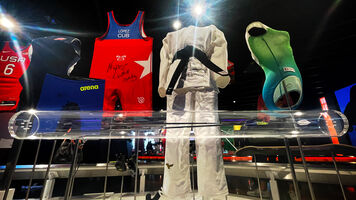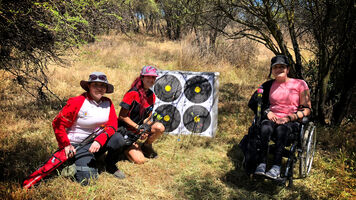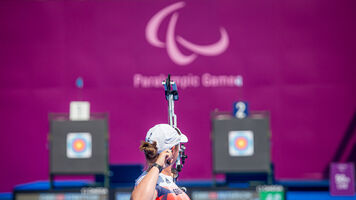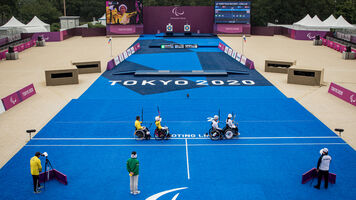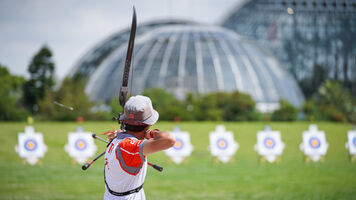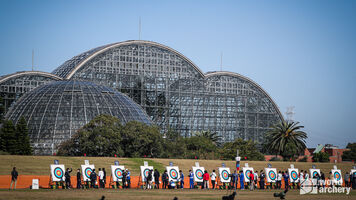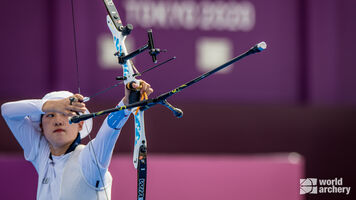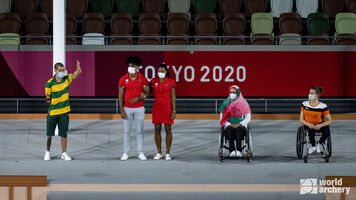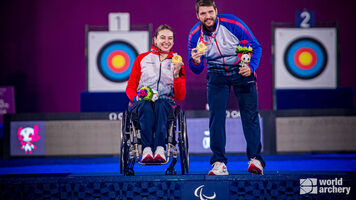Preview: Compound events at the Tokyo 2020 Paralympic Games
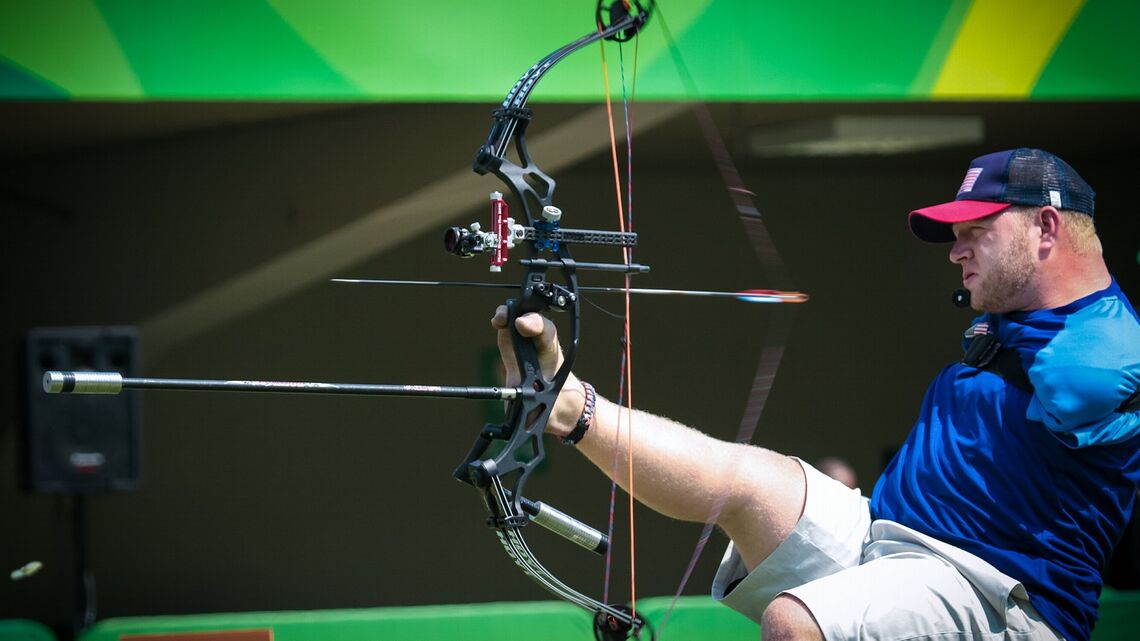
Compound was made a distinct discipline at the Paralympic Games in 2008 – bringing the rules for using the bow into line with other international events, including able-bodied tournaments.
Being mechanically more efficient, and allowing for the use of release aids, compounds can be easier for people with certain physical impairments to use. It’s often the category in which we see the most inventive side of the sport. There’ll be plenty of shoulder-mounted releases, triggered by the jaw or a bite button in the mouth, and a wide variety of body shapes and types on the line.
It’s also where we’re likely to see some excellent scores posted.
At the last world para championships, 10 men broke 690 points and one, Armless Archer Matt Stutzman, was above 700. If the conditions for qualifying on 27 August are as settled as they were during the Olympics, the Paralympic records of 687 (men) and 674 (women) are surely under threat.
Key information
What’s happening? The compound events at the Tokyo 2020 Paralympic Games, with finals on 29-31 August 2021.
What’s at stake? Three Paralympic titles in men’s individual, women’s individual and mixed team competitions.
Who’s competing? 36 men, 24 women and 11 mixed teams.
What’s the story? Matt Stutzman is probably the best-known para archer in the world, especially since he played a starring role in the recent documentary from the Paralympics, Rising Phoenix. The self-named ‘Armless Archer’ is competing at his third Games in Tokyo. His best result so far is a second at London 2012.
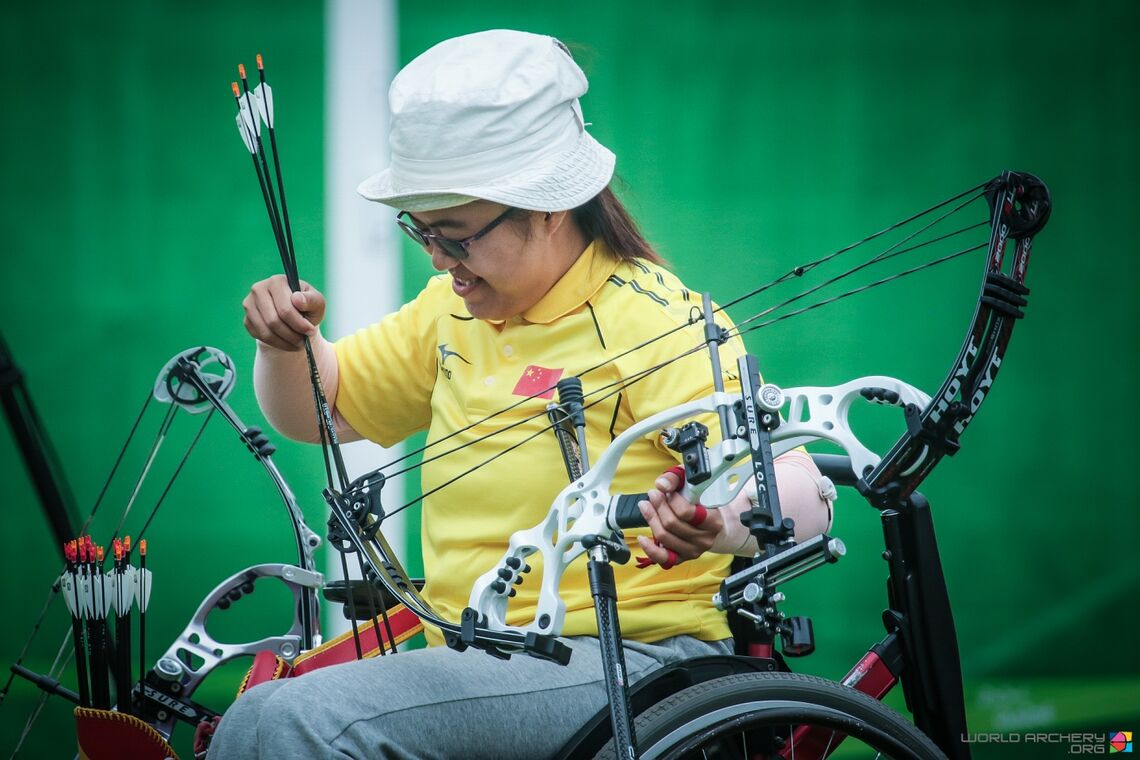
Podium at Rio 2016
The men’s individual podium:
- Andre Shelby, USA
- Alberto Simonelli, Italy
- Jonathon Milne, Australia
The women’s individual podium:
- Zhou Jiamin, China
- Lin Yueshan, China
- Kim Mi Soon, Korea
The mixed team podium:
 China
China Great Britain
Great Britain Korea
Korea
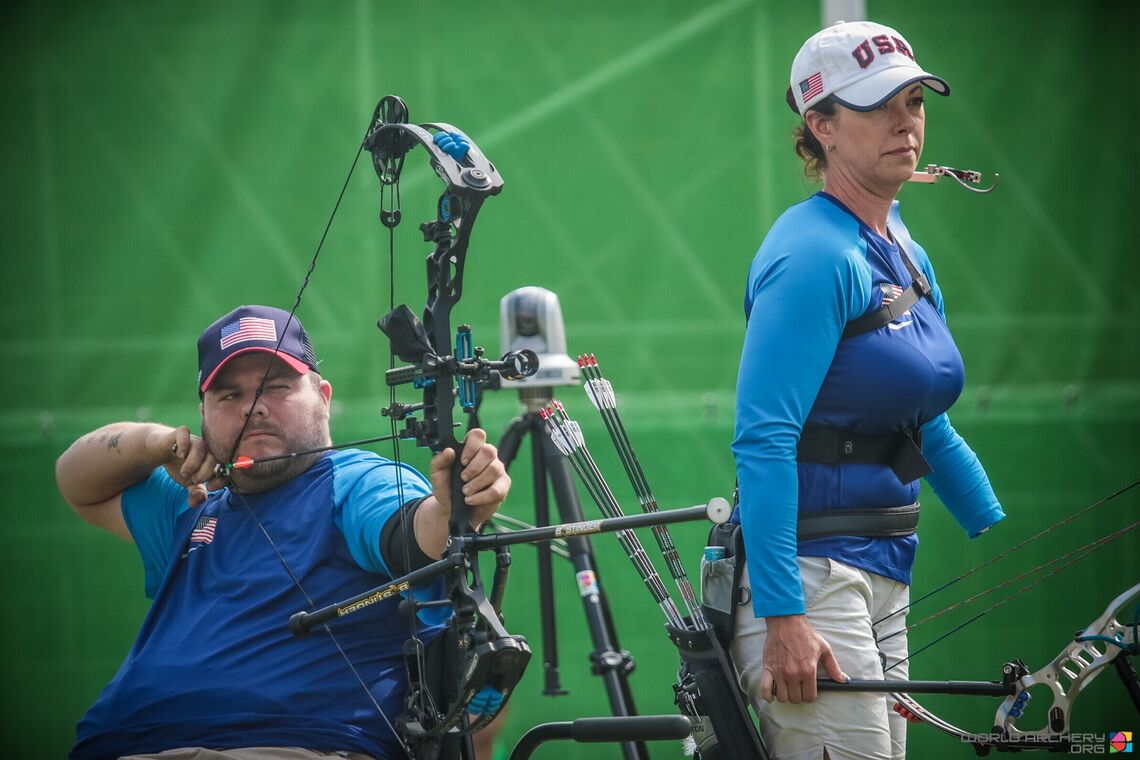
Line-up
Correct as of 19 August 2021. Nations in bold also compete in the mixed team event.
 Australia: 2 (2 men) – Peter Marchant, Jonathon Milne
Australia: 2 (2 men) – Peter Marchant, Jonathon Milne Belgium: 1 (1 man) – Piotr van Montagu
Belgium: 1 (1 man) – Piotr van Montagu Brazil: 2 (1 man, 1 woman) – Andrey de Castro, Jane Karla Gogel
Brazil: 2 (1 man, 1 woman) – Andrey de Castro, Jane Karla Gogel Canada: 1 (1 woman) – Karen van Nest
Canada: 1 (1 woman) – Karen van Nest Chile: 1 (1 woman) – Mariana Zuniga
Chile: 1 (1 woman) – Mariana Zuniga China: 5 (2 men, 3 women) – Ai Xinliang, He Zihao, Li Xinru, Lin Yueshan, Zhou Jiamin
China: 5 (2 men, 3 women) – Ai Xinliang, He Zihao, Li Xinru, Lin Yueshan, Zhou Jiamin Costa Rica: 1 (1 man) – Diego Quesada
Costa Rica: 1 (1 man) – Diego Quesada Finland: 1 (1 man) – Jere Forsberg
Finland: 1 (1 man) – Jere Forsberg France: 3 (2 men, 1 woman) – Daniel Lelou, Eric Pereira, Julie Chupin
France: 3 (2 men, 1 woman) – Daniel Lelou, Eric Pereira, Julie Chupin Great Britain: 4 (2 men, 2 women) – Nathan MacQueen, John Stubbs, Phoebe Pine, Jess Stretton
Great Britain: 4 (2 men, 2 women) – Nathan MacQueen, John Stubbs, Phoebe Pine, Jess Stretton Hong Kong China: 1 (1 man) – Ngai Ka Chuen
Hong Kong China: 1 (1 man) – Ngai Ka Chuen India: 3 (2 men, 1 woman) – Rakesh Kumar, Sundar Swami Shyam, Jyoti
India: 3 (2 men, 1 woman) – Rakesh Kumar, Sundar Swami Shyam, Jyoti Iran: 3 (2 men, 1 woman) – Ramezan Biabani, Alisina Manshaezadeh, Farzaneh Asgari
Iran: 3 (2 men, 1 woman) – Ramezan Biabani, Alisina Manshaezadeh, Farzaneh Asgari Iraq: 1 (1 man) – Sulaiman Sulaiman
Iraq: 1 (1 man) – Sulaiman Sulaiman Ireland: 1 (1 woman) – Kerrie-Louise Leonard
Ireland: 1 (1 woman) – Kerrie-Louise Leonard Italy: 4 (2 men, 2 women) – Matteo Bonacina, Giampaolo Cancelli, Eleonora Sarti, Maria Andrea Virgilio
Italy: 4 (2 men, 2 women) – Matteo Bonacina, Giampaolo Cancelli, Eleonora Sarti, Maria Andrea Virgilio Japan: 2 (1 man, 1 woman) – Leon Miyamoto, Miho Nagano
Japan: 2 (1 man, 1 woman) – Leon Miyamoto, Miho Nagano Korea: 1 (1 woman) – Choi Na Mi
Korea: 1 (1 woman) – Choi Na Mi Malaysia: 1 (1 man) – Wiro Julin
Malaysia: 1 (1 man) – Wiro Julin Mexico: 1 (1 man) – Omar Echeverria
Mexico: 1 (1 man) – Omar Echeverria RPC: 4 (2 men, 2 women) – Nail Gatin, Bair Shigaev, Tatiana Andrievskaia, Stepanida Artakhinova
RPC: 4 (2 men, 2 women) – Nail Gatin, Bair Shigaev, Tatiana Andrievskaia, Stepanida Artakhinova Singapore: 1 (1 woman) – Alim Nur Syahidah
Singapore: 1 (1 woman) – Alim Nur Syahidah Slovakia: 2 (2 men) – Marian Marecak, Marcel Pavlik
Slovakia: 2 (2 men) – Marian Marecak, Marcel Pavlik South Africa: 1 (1 man) – Philip Coates-Palgrave
South Africa: 1 (1 man) – Philip Coates-Palgrave Spain: 1 (1 woman) – Carmen Rubio
Spain: 1 (1 woman) – Carmen Rubio Sweden: 1 (1 woman) – Zandra Reppe
Sweden: 1 (1 woman) – Zandra Reppe Thailand: 3 (2 men, 1 woman) – Anon Aungaphinan, Comsan Singpirom, Praphaporn Homjanthuek
Thailand: 3 (2 men, 1 woman) – Anon Aungaphinan, Comsan Singpirom, Praphaporn Homjanthuek Turkey: 4 (2 men, 2 women) – Bulent Korkmaz, Murat Turan, Oznur Cure, Sevgi Yorulmaz
Turkey: 4 (2 men, 2 women) – Bulent Korkmaz, Murat Turan, Oznur Cure, Sevgi Yorulmaz Ukraine: 1 (1 man) – Serhiy Atamanenko
Ukraine: 1 (1 man) – Serhiy Atamanenko USA: 3 (3 men) – Kevin Polish, Andre Shelby, Matt Stutzman
USA: 3 (3 men) – Kevin Polish, Andre Shelby, Matt Stutzman
Competition
Archers competing in the compound division at the Tokyo 2020 Paralympic Games have an open classification, meaning they usually have impairment in either the top or bottom half or one side of their bodies.
There are individual and mixed team events. A mixed team consists of two archers, one man and one woman, from the same nation.
Compound archers shoot over a distance of 50 metres at targets measuring 80 centimetres in diameter, with the outer four rings removed, aiming to hit a 10-ring measuring just eight centimetres in diameter.
Archers and mixed teams are seeded on the results of qualifying, which consists of 72 arrows shot for total score on 27 August, and progress through head-to-head brackets, in which the winner of each match advances and the loser is eliminated until a champion is crowned.
Compound matches are decided using cumulative scoring, in which the goal is to have the highest points total after a certain number of arrows. That number is 15 arrows, split into five ends of three, in individual matches and 16 arrows, split into four ends of four, in mixed team matches.
If an individual match is tied after 15 arrows or a mixed team match tied after 16 arrows, then the match is sent to a tiebreak or shoot-off.
Each archer shoots an arrow. In an individual match, the archer whose arrow lands closest to the middle of the target wins the match. In a mixed team match, the nation that has the highest score with its two arrows wins the match but, if tied, victory goes to whichever nation has an arrow closer to the middle of the target.

 China
China Great Britain
Great Britain Korea
Korea Australia: 2 (2 men) – Peter Marchant, Jonathon Milne
Australia: 2 (2 men) – Peter Marchant, Jonathon Milne Belgium: 1 (1 man) – Piotr van Montagu
Belgium: 1 (1 man) – Piotr van Montagu Brazil: 2 (1 man, 1 woman) – Andrey de Castro, Jane Karla Gogel
Brazil: 2 (1 man, 1 woman) – Andrey de Castro, Jane Karla Gogel Canada: 1 (1 woman) – Karen van Nest
Canada: 1 (1 woman) – Karen van Nest Chile: 1 (1 woman) – Mariana Zuniga
Chile: 1 (1 woman) – Mariana Zuniga Costa Rica: 1 (1 man) – Diego Quesada
Costa Rica: 1 (1 man) – Diego Quesada Finland: 1 (1 man) – Jere Forsberg
Finland: 1 (1 man) – Jere Forsberg France: 3 (2 men, 1 woman) – Daniel Lelou, Eric Pereira, Julie Chupin
France: 3 (2 men, 1 woman) – Daniel Lelou, Eric Pereira, Julie Chupin Hong Kong China: 1 (1 man) – Ngai Ka Chuen
Hong Kong China: 1 (1 man) – Ngai Ka Chuen India: 3 (2 men, 1 woman) – Rakesh Kumar, Sundar Swami Shyam, Jyoti
India: 3 (2 men, 1 woman) – Rakesh Kumar, Sundar Swami Shyam, Jyoti Iran: 3 (2 men, 1 woman) – Ramezan Biabani, Alisina Manshaezadeh, Farzaneh Asgari
Iran: 3 (2 men, 1 woman) – Ramezan Biabani, Alisina Manshaezadeh, Farzaneh Asgari Iraq: 1 (1 man) – Sulaiman Sulaiman
Iraq: 1 (1 man) – Sulaiman Sulaiman Ireland: 1 (1 woman) – Kerrie-Louise Leonard
Ireland: 1 (1 woman) – Kerrie-Louise Leonard Italy: 4 (2 men, 2 women) – Matteo Bonacina, Giampaolo Cancelli, Eleonora Sarti, Maria Andrea Virgilio
Italy: 4 (2 men, 2 women) – Matteo Bonacina, Giampaolo Cancelli, Eleonora Sarti, Maria Andrea Virgilio Japan: 2 (1 man, 1 woman) – Leon Miyamoto, Miho Nagano
Japan: 2 (1 man, 1 woman) – Leon Miyamoto, Miho Nagano Malaysia: 1 (1 man) – Wiro Julin
Malaysia: 1 (1 man) – Wiro Julin Mexico: 1 (1 man) – Omar Echeverria
Mexico: 1 (1 man) – Omar Echeverria RPC: 4 (2 men, 2 women) – Nail Gatin, Bair Shigaev, Tatiana Andrievskaia, Stepanida Artakhinova
RPC: 4 (2 men, 2 women) – Nail Gatin, Bair Shigaev, Tatiana Andrievskaia, Stepanida Artakhinova Singapore: 1 (1 woman) – Alim Nur Syahidah
Singapore: 1 (1 woman) – Alim Nur Syahidah Slovakia: 2 (2 men) – Marian Marecak, Marcel Pavlik
Slovakia: 2 (2 men) – Marian Marecak, Marcel Pavlik South Africa: 1 (1 man) – Philip Coates-Palgrave
South Africa: 1 (1 man) – Philip Coates-Palgrave Spain: 1 (1 woman) – Carmen Rubio
Spain: 1 (1 woman) – Carmen Rubio Sweden: 1 (1 woman) – Zandra Reppe
Sweden: 1 (1 woman) – Zandra Reppe Thailand: 3 (2 men, 1 woman) – Anon Aungaphinan, Comsan Singpirom, Praphaporn Homjanthuek
Thailand: 3 (2 men, 1 woman) – Anon Aungaphinan, Comsan Singpirom, Praphaporn Homjanthuek Turkey: 4 (2 men, 2 women) – Bulent Korkmaz, Murat Turan, Oznur Cure, Sevgi Yorulmaz
Turkey: 4 (2 men, 2 women) – Bulent Korkmaz, Murat Turan, Oznur Cure, Sevgi Yorulmaz Ukraine: 1 (1 man) – Serhiy Atamanenko
Ukraine: 1 (1 man) – Serhiy Atamanenko USA: 3 (3 men) – Kevin Polish, Andre Shelby, Matt Stutzman
USA: 3 (3 men) – Kevin Polish, Andre Shelby, Matt Stutzman
